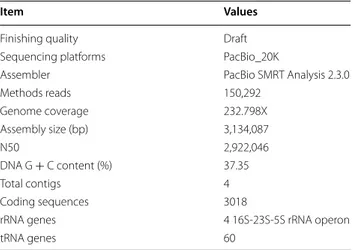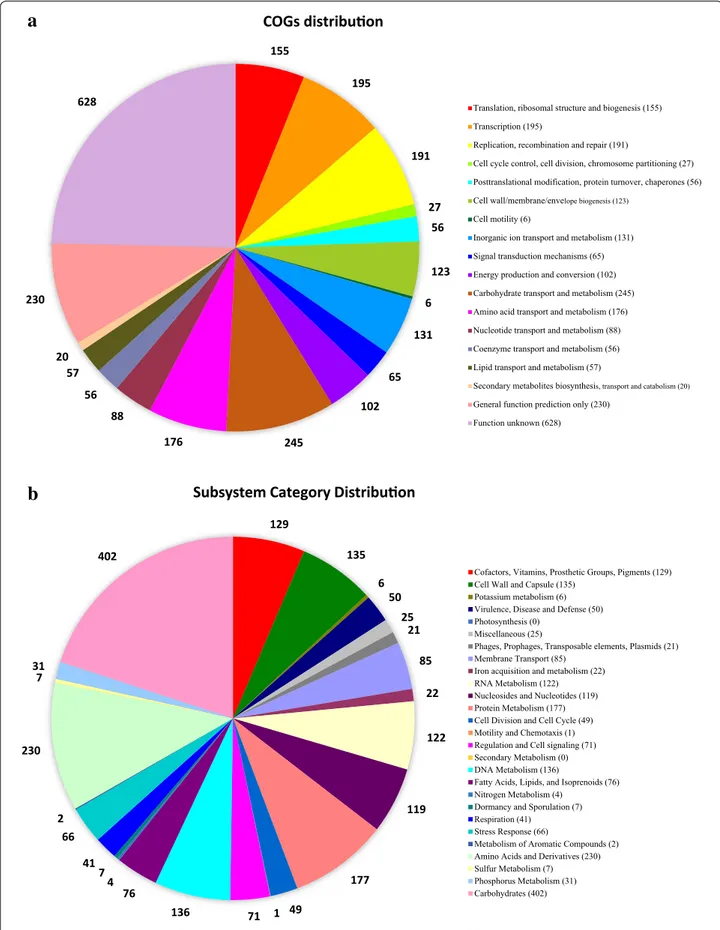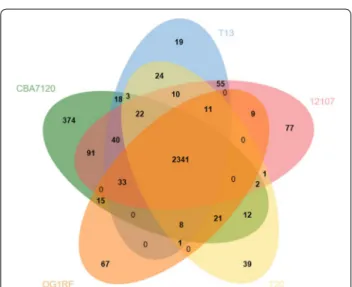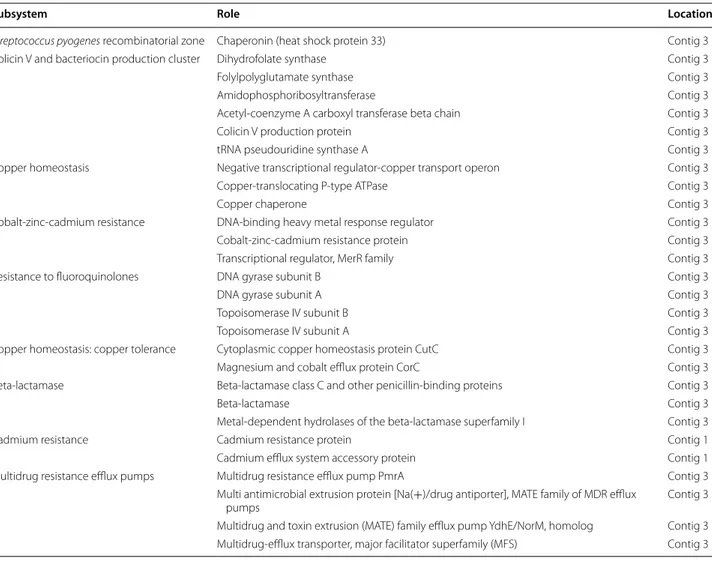GENOME REPORT
Genome sequence of a commensal
bacterium, Enterococcus faecalis CBA7120,
isolated from a Korean fecal sample
Joon Yong Kim
1, Hye Seon Song
1,2, Yeon Bee Kim
1,2, Joseph Kwon
1, Jong‑Soon Choi
1, Yong‑Joon Cho
3,
Byung‑Yong Kim
3, Jin‑Kyu Rhee
2, Jinjong Myoung
4, Young‑Do Nam
5,6†and Seong Woon Roh
1,6*†Abstract
Background: Enterococcus faecalis, the type strain of the genus Enterococcus, is not only a commensal bacterium in
the gastrointestinal tract in vertebrates and invertebrates, but also causes serious disease as an opportunistic patho‑ gen. To date, genome sequences have been published for over four hundred E. faecalis strains; however, pathogenic‑ ity of these microbes remains complicated. To increase our knowledge of E. faecalis virulence factors, we isolated strain CBA7120 from the feces of an 81‑year‑old female from the Republic of Korea and performed a comparative genomic analysis.
Results: The genome sequence of E. faecalis CBA7120 is 3,134,087 bp in length, with a G + C content of 37.35 mol%,
and is comprised of four contigs with an N50 value of 2,922,046 bp. The genome showed high similarity with other strains of E. faecalis, including OG1RF, T13, 12107 and T20, based on OrthoANI values. Strain CBA7120 contains 374 pan‑genome orthologous groups (POGs) as singletons, including “Phages, Prophages, Transposable elements, Plas‑ mids,” “Carbohydrates,” “DNA metabolism,” and “Virulence, Disease and Defense” subsystems. Genes related to multid‑ rug resistance efflux pumps were annotated in the genome.
Conclusions: The comparative genomic analysis of E. faecalis strains presented in this study was performed using a
variety of analysis methods and will facilitate future identification of hypothetical proteins.
Keywords: Enterococcus faecalis, Genome sequence, Comparative genomics, Virulence factors
© The Author(s) 2016. This article is distributed under the terms of the Creative Commons Attribution 4.0 International License
(http://creativecommons.org/licenses/by/4.0/), which permits unrestricted use, distribution, and reproduction in any medium,
provided you give appropriate credit to the original author(s) and the source, provide a link to the Creative Commons license, and indicate if changes were made. The Creative Commons Public Domain Dedication waiver (http://creativecommons.org/
publicdomain/zero/1.0/) applies to the data made available in this article, unless otherwise stated.
Background
Genus Enterococcus is a common member of the nor-mal intestinal flora in various species, both vertebrates and invertebrates. However, some species in the genus
Enterococcus are leading causes of highly contagious
hospital-acquired infections, including urinary tract, intra-abdominal, pelvic, and soft tissue infections, as well as bacteremia and endocarditis. Thus, members of the genus Enterococcus have been extensively studied. The genus Enterococcus was first described by Schleifer and Kilpper-Balz [1] and species of the genus Enterococcus
are Gram-positive, non-spore-forming, facultative anaer-obic microbes that produce lactic acid. Enterococcus
fae-calis DSM 20478T is the type species for the genus [2]. The first genome sequence of Enterococcus was pub-lished by Paulsen in 2003 with E. faecalis V583 [2]. To date, more than 400 strains of E. faecalis have been sequenced and analyzed. The virulence factors present in E. faecalis are well established, and include aggre-gation substances, surface adhesins, sex pheromones, lipoteichoic acid, extracellular superoxide, the lytic enzymes gelatinase and hyaluronidase, and the toxin cytolysin, but novel virulence factors continue to be reported [3]. In this study, we performed sequencing and genomic analysis of E. faecalis CBA7120, isolated from the feces of an 81-year-old female. Comparison of genomic data from E. faecalis CBA7120 with other
Open Access
*Correspondence: seong18@gmail.com
†Young‑Do Nam and Seong Woon Roh contributed equally to this work 1 Biological Disaster Analysis Group, Korea Basic Science Institute, Daejeon 34133, South Korea
genomes of E. faecalis may improve our understand-ing of the virulence factors and pathogenesis present in
Enterococcus. Methods
Strain isolation and DNA extraction
Enterococcus faecalis CBA7120 was isolated from the
feces of an 81-year-old healthy female living in the Republic of Korea and cultivated on modified Eggerth– Gagnon (EG) medium [containing per liter of distilled water: peptone 10 g, Na2HPO4 4 g, porcine gastric mucin 2 g, sheep blood 50 ml, agar 15 g] at 37 °C for 24 h in an anaerobic chamber (Coy Laboratory Products). Once a pure culture was obtained, strain CBA7120 was pre-served at −80 °C in a suspension of 20% glycerol for long-term storage. Genomic DNA for sequencing was prepared using QuickGene DNA tissue kit S (Kurabo, Japan) and QIAamp DNA extraction Kits (Qiagen, USA).
Whole genome sequencing, assembly, and gene annotation
A SMRTbell library was constructed according to the Pacific Biosciences protocol “20-kb Template Prepara-tion Using BluePippin Size-selecPrepara-tion system (15-kb Size Cutoff)”. The library was sequenced using P6-C4 chemis-try on a Pacific Biosciences RS II instrument. The PacBio RS II sequencing system generated 150,292 reads, with an average read length of 8095 bp from one SMRT cell. For the assembly, filtering was performed by Hierarchical Genome Assembly Process (HGAP) version 2 protocol with default parameter. Assembly was performed using the HGAP 2 protocol with default parameters in SMRT Analysis version 2.3 [4]. The assembly was polished with three successive passes through Quiver to reach a final consensus accuracy of >99.988% at 232.798 × cover-age. Finally, finished assembly consisted of four contigs. Using RS_Modification_and_Motif_analysis protocol with default parameter in PacBio SMRT analysis pipeline, 4 N6-methyladenine and other six unidentified methyl-ated motifs were identified. Gene prediction was accom-plished using Glimmer3 [5] on the Rapid Annotation using Subsystem Technology (RAST; http://rast.nmpdr. org/) server [6], and gene annotation was performed using the SEED and Clusters of Orthologous Groups (COG; http://www.ncbi.nlm.nih.gov/COG/) databases [7, 8]. RNAmmer 1.2 [9] and tRNAscan-SE 1.21 [10] were used to identify rRNA and tRNA sequences, respectively.
Multilocus sequence typing (MLST)
MLST was performed using the following seven house-keeping genes: glucose-6-phosphate dehydrogenase (gdh), glyceraldehyde-3-phosphate dehydrogenase (gyd), phosphate ATP binding cassette transporter (pstS), glu-cokinase (gki), shikimate-5-dehydrogenase (aroE), xan-thine phosphoribosyltransferase (xpt), and acetyl-CoA acetyltransferase (yiqL) using PubMLST (http://pubmlst. org/efaecalis/).
Comparative genomic analysis
Using data in the NCBI genome database (http://www. ncbi.nlm.nih.gov/genome/), four E. faecalis strains were selected as the closest neighbors of strain CBA7120 (>89% symmetric identity): E. faecalis strain 12107, T13, OG1RF, and T20, and these genomes were used for comparative genomic analysis. The genome of E.
faeca-lis TX0031 also showed high symmetric identity, but it
was excluded from further analysis because the genome contains a large number of contigs. For whole-genome comparison, the genomes of strain CBA7120 and the other related strains were aligned using the progressive MAUVE algorithm in the MAUVE multiple genome alignment software 2.4.0 [11]. The OrthoANI algorithm was used to assess overall similarity between two genome sequences [12]. OrthoANI values were obtained and a phylogenetic tree was constructed based on OrthoANI analysis of the E. faecalis strains CBA7120, 12107, T13, OG1RF, and T20 using the orthologous average nucleo-tide identity tool [12]. Orthologs in the genomes of strain CBA7120 and other related strains were identi-fied using reciprocal best hit (RBH) in the UBLAST program [13]. Pan-genome orthologous groups (POGs) were constructed using the EzBioCloud Comparative Genomics Database (http://cg.ezbiocloud.net/). For the visualization heat map and the dendrogram based on the gene content (presence or absence) of the genomes of strain CBA7120 and the other four strains, Jaccard coeffi-cients and UPGMA clustering were used to calculate the presence of POGs and genome clustering, respectively. The Venn diagram based on POGs shared between strain CBA7120 and related strains was constructed using the jvenn program [14].
Quality assurance
To obtain pure cultures, a single colony of strain CBA7120 was repeatedly transferred to fresh modified
EG medium more than three times, and confirmed using electron microscopy (Fig. 1). Genomic DNA of strain CBA7120 was purified using an MG Genomic DNA purification kit (Doctor Protein) and the 16S rRNA gene sequence from the draft genome was used to check for contamination.
Results and discussion
General features
General genome features of E. faecalis CBA7120 are shown in Table 1. The genome sequence of strain CBA7120 is 3,134,087 bp in length, with a G + C
content of 37.35 mol%, and is comprised of four con-tigs with an N50 value of 2,922,046 bp. Using BLAST in the NCBI, we found that contig 1, 2 and 4 represented plasmid sequences and contig 3 represented chro-mosome sequence. The genome contains 3018 cod-ing DNA sequences (CDSs), 60 tRNA genes, and four 16S-23S-5S rRNA operons. The distribution of COGs and SEED subsystems is illustrated in Fig. 2. The most abundant COG categories were G (carbohydrate trans-port and metabolism), R (general function prediction only), K (transcription), L (replication, recombination and repair), E (amino acid transport and metabolism), J (translation, ribosomal structure and biogenesis), and P (inorganic ion transport and metabolism); the S cat-egory (function unknown) was also abundant (Fig. 2a). The SEED subsystems “Carbohydrates”, “Amino Acids and Derivatives”, “Protein Metabolism”, “DNA Metabo-lism”, “Cell Wall and Capsule”, “Cofactors, Vitamins, Prosthetic Groups, Pigments”, “RNA Metabolism”, and “Nucleosides and Nucleotides” subsystems were most abundant (Fig. 2b).
Multilocus sequence typing (MLST)
Enterococcus faecalis CBA7120 was typed with MLST at
loci gdh 1, gyd 7, pstS 9, gki 1, aroE 1, xpt 3, and yqiL 1, and was classified as sequence type 5 (ST 5) containing solely strain B343 that was isolated from a chicken prod-uct in Spain.
Comparative genomics of strain CBA7120 with other E.
faecalis strains
Whole-genome comparison of strain CBA7120 with E.
faecalis 12107, T13, OG1RF, and T20 showed that most
of the locally collinear blocks (LCBs) are highly homolo-gous between the five assemblies, although the genome of strain CBA7120 contains large gaps in three LCBs (Fig. 3). E. faecalis CBA7120 showed 99.24, 99.55, 99.62 and 99.64% orthoANI values with E. faecalis strains OG1RF, T13, 12107, and T20, respectively. The phyloge-netic tree based on orthoANI values for strain CBA7120 and the four reference strains indicated that strain CBA7120 is closely related to the E. faecalis reference strains (Fig. 4a). Based on analysis of the gene presence or absence heat map, strain CBA7120 possesses differ-ent POGs from the other four strains. In the dendro-gram based on presence of POGs, strain CBA7120 was located as an outgroup to the other E. faecalis strains (Fig. 4b). As shown in Fig. 5, strain CBA7120 and the
Fig. 1 Photomicrograph of Enterococcus faecalis CBA7120
Table 1 General genome features of Enterococcus faecalis CBA7120
Item Values
Finishing quality Draft
Sequencing platforms PacBio_20K
Assembler PacBio SMRT Analysis 2.3.0
Methods reads 150,292 Genome coverage 232.798X Assembly size (bp) 3,134,087 N50 2,922,046 DNA G + C content (%) 37.35 Total contigs 4 Coding sequences 3018
rRNA genes 4 16S‑23S‑5S rRNA operon
155 195 191 27 56 123 6 131 65 102 245 176 88 56 57 20 230
628 Translation, ribosomal structure and biogenesis (155)
Transcription (195)
Replication, recombination and repair (191)
Cell cycle control, cell division, chromosome partitioning (27) Posttranslational modification, protein turnover, chaperones (56) Cell wall/membrane/envelope biogenesis (123)
Cell motility (6)
Inorganic ion transport and metabolism (131) Signal transduction mechanisms (65) Energy production and conversion (102) Carbohydrate transport and metabolism (245) Amino acid transport and metabolism (176) Nucleotide transport and metabolism (88) Coenzyme transport and metabolism (56) Lipid transport and metabolism (57)
Secondary metabolites biosynthesis, transport and catabolism (20)
General function prediction only (230) Function unknown (628)
COGs distribu on
a
b
129 135 6 50 25 21 85 22 122 119 177 49 1 71 136 76 4 7 41 66 2 230 7 31 402Cofactors, Vitamins, Prosthetic Groups, Pigments (129) Cell Wall and Capsule (135)
Potassium metabolism (6) Virulence, Disease and Defense (50) Photosynthesis (0)
Miscellaneous (25)
Phages, Prophages, Transposable elements, Plasmids (21) Membrane Transport (85)
Iron acquisition and metabolism (22) RNA Metabolism (122) Nucleosides and Nucleotides (119) Protein Metabolism (177) Cell Division and Cell Cycle (49) Motility and Chemotaxis (1) Regulation and Cell signaling (71) Secondary Metabolism (0) DNA Metabolism (136)
Fatty Acids, Lipids, and Isoprenoids (76) Nitrogen Metabolism (4)
Dormancy and Sporulation (7) Respiration (41)
Stress Response (66)
Metabolism of Aromatic Compounds (2) Amino Acids and Derivatives (230) Sulfur Metabolism (7) Phosphorus Metabolism (31) Carbohydrates (402)
Subsystem Category Distribu on
Fig
. 3
M
AUVE alig
nment of the genome of
Enter oc oc cus f aec alis
CBA7120 and the genomes of strains OG1RF
, T13, 12107, and
T20.
The locally collinear blocks (L
CBs) r
epr
esent highly homologous
reg ions and ar e sho wn with identical colors . T he genomes w er e dra wn t
other four strains share 2341 POGs. The genome of strain CBA7120 contains only 374 POGs as single-tons, contained in a single genome. Without the POGs that had no match in the SEED database, most of the 91 POGs identified belong to the “Phages, Prophages, Transposable elements, Plasmids” (20 POGs), “Carbo-hydrates” (12 POGs), “DNA metabolism” (11 POGs), and “Virulence, Disease and Defense” subsystems (9 POGs).
Virulence factors
Based on comparison with the SEED database, 28 CDS were annotated as belonging to the “Virulence, Disease, Defense” category (Table 2). Strain CBA7120 was found to contain genes related to multidrug resistance efflux pumps, such as multidrug resistance efflux pump PmrA, multi antimicrobial extrusion protein, multidrug and toxin extrusion (MATE) family efflux pump YdhE/NorM, and multidrug-efflux transporter.
Fig. 4 Dendrogram based on OrthoANI analysis and the presence of POGs in the genome of Enterococcus faecalis CBA7120 and the genomes of
strains OG1RF, T13, 12107, and T20. a ANI phylogenetic tree. Using the orthologous average nucleotide identity tool, the phylogenetic tree was con‑ structed based on OrthoANI values. b Dendrogram based on presence of POGs. Using Jaccard coefficients and UPGMA clustering, a dendrogram was generated. Blue indicates present genes and red indicates absent genes
Fig. 5 Venn diagram representing the pan‑genomic landscape of
Enterococcus faecalis CBA7120 and strains OG1RF, T13, 12107, and T20.
The numbers in the Venn diagram indicate the number of POGs found to be shared among the indicated genomes
Future directions
Genomic analysis based on ortholog analysis may be a powerful comparative genomics tool. Additional study of the virulence factors present in E. faecalis CBA7120 will guide further research on E. faecalis virulence.
Abbreviations
CDSs: coding DNA sequences; COG: clusters of orthologous groups; EG: Egg‑ erth–Gagnon medium; LCB: locally collinear block; MATE: multidrug and toxin extrusion; MLST: multilocus sequence typing; POG: pan‑genome orthologous group; RAST: rapid annotation using subsystem technology; RBH: reciprocal best hit.
Authors’ contributions
YDN and SWR designed and coordinated all the experiments. HSS character‑ ized the strain and prepared the high‑quality DNA. JYK, YJC, BYK performed
the sequence assembly, gene prediction, gene annotation, comparative genomic analysis and wrote manuscript. YBK, JK, JSC, JKR and JM checked and edited the manuscript. All authors read and approved the final manuscript. Author details
1 Biological Disaster Analysis Group, Korea Basic Science Institute, Dae‑ jeon 34133, South Korea. 2 Department of Food Science and Engineer‑ ing, Ewha Womans University, Seoul 03760, South Korea. 3 ChunLab Inc., Seoul National University, Seoul 151‑742, South Korea. 4 Korea Zoonosis Research Institute, Chonbuk National University, Jeonju 561‑756, South Korea. 5 Research Group of Gut Microbiome, Korea Food Research Institute, Seongnam 13539, South Korea. 6 University of Science and Technology, Dae‑ jeon 34113, South Korea.
Acknowledgements Not applicable. Competing interests
The authors declare that they have no competing interests.
Table 2 Summary of protein coding sequences annotated as belonging to the “Virulence, Disease, and Defense” subsys-tem in the SEED database
Subsystem Role Location
Streptococcus pyogenes recombinatorial zone Chaperonin (heat shock protein 33) Contig 3
Colicin V and bacteriocin production cluster Dihydrofolate synthase Contig 3
Folylpolyglutamate synthase Contig 3
Amidophosphoribosyltransferase Contig 3
Acetyl‑coenzyme A carboxyl transferase beta chain Contig 3
Colicin V production protein Contig 3
tRNA pseudouridine synthase A Contig 3
Copper homeostasis Negative transcriptional regulator‑copper transport operon Contig 3
Copper‑translocating P‑type ATPase Contig 3
Copper chaperone Contig 3
Cobalt‑zinc‑cadmium resistance DNA‑binding heavy metal response regulator Contig 3
Cobalt‑zinc‑cadmium resistance protein Contig 3
Transcriptional regulator, MerR family Contig 3
Resistance to fluoroquinolones DNA gyrase subunit B Contig 3
DNA gyrase subunit A Contig 3
Topoisomerase IV subunit B Contig 3
Topoisomerase IV subunit A Contig 3
Copper homeostasis: copper tolerance Cytoplasmic copper homeostasis protein CutC Contig 3 Magnesium and cobalt efflux protein CorC Contig 3 Beta‑lactamase Beta‑lactamase class C and other penicillin‑binding proteins Contig 3
Beta‑lactamase Contig 3
Metal‑dependent hydrolases of the beta‑lactamase superfamily I Contig 3
Cadmium resistance Cadmium resistance protein Contig 1
Cadmium efflux system accessory protein Contig 1
Multidrug resistance efflux pumps Multidrug resistance efflux pump PmrA Contig 3 Multi antimicrobial extrusion protein [Na(+)/drug antiporter], MATE family of MDR efflux
pumps Contig 3
Multidrug and toxin extrusion (MATE) family efflux pump YdhE/NorM, homolog Contig 3 Multidrug‑efflux transporter, major facilitator superfamily (MFS) Contig 3
• We accept pre-submission inquiries
• Our selector tool helps you to find the most relevant journal
• We provide round the clock customer support
• Convenient online submission
• Thorough peer review
• Inclusion in PubMed and all major indexing services
• Maximum visibility for your research Submit your manuscript at
www.biomedcentral.com/submit
Submit your next manuscript to BioMed Central
and we will help you at every step:
Availability of data and materials
This Whole Genome Shotgun project has been deposited at DDBJ under the accession numbers BDEN01000001–BDEN01000004.
Ethics approval and consent to participate
This study was approved by the Institutional Review Board of the Korea National Institutes of Health (NIH) under approval number 2015‑02‑EXP‑05‑3C‑A.
Funding
This research was supported from the Basic Science Research Program through the National Research Foundation of Korea (NRF) funded by the Ministry of Education, Science, and Technology (2015R1D1A1A09061039), from the Center for Analytical Research of Disaster Science of the Korea Basic Science Institute (C36703), from Korean Food Research Institute (E0131600‑04) and from Korea Centers for Disease Control and Prevention (4847‑311‑210‑13, 2015).
Received: 24 August 2016 Accepted: 19 November 2016
References
1. Schleifer KH, Kilpper‑Bälz R. Transfer of Streptococcus faecalis and
Strep-tococcus faecium to the Genus Enterococcus nom. rev. as Enterococcus faecalis comb. nov. and Enterococcus faecium comb. nov. Int J Syst Evol
Microbiol. 1984;34:31–4.
2. Paulsen IT, Banerjei L, Myers GS, Nelson KE, Seshadri R, Read TD, et al. Role of mobile DNA in the evolution of vancomycin‑resistant Enterococcus
faecalis. Science. 2003;299:2071–4.
3. Kayaoglu G, Orstavik D. Virulence factors of Enterococcus faecalis: relation‑ ship to endodontic disease. Crit Rev Oral Biol Med. 2004;15:308–20.
4. Chin CS, Alexander DH, Marks P, Klammer AA, Drake J, Heiner C, et al. Nonhybrid, finished microbial genome assemblies from long‑read SMRT sequencing data. Nat Methods. 2013;10:563–9.
5. Delcher AL, Bratke KA, Powers EC, Salzberg SL. Identifying bacterial genes and endosymbiont DNA with Glimmer. Bioinformatics. 2007;23:673–9. 6. Aziz RK, Bartels D, Best AA, DeJongh M, Disz T, Edwards RA, et al. The RAST
server: rapid annotations using subsystems technology. BMC Genomics. 2008;9:75.
7. Galperin MY, Makarova KS, Wolf YI, Koonin EV. Expanded microbial genome coverage and improved protein family annotation in the COG database. Nucleic Acids Res. 2015;43:D261–9.
8. Overbeek R, Begley T, Butler RM, Choudhuri JV, Chuang HY, Cohoon M, et al. The subsystems approach to genome annotation and its use in the project to annotate 1000 genomes. Nucleic Acids Res. 2005;33:5691–702. 9. Lagesen K, Hallin P, Rodland EA, Staerfeldt HH, Rognes T, Ussery DW.
RNAmmer: consistent and rapid annotation of ribosomal RNA genes. Nucleic Acids Res. 2007;35:3100–8.
10. Lowe TM, Eddy SR. tRNAscan‑SE: a program for improved detec‑ tion of transfer RNA genes in genomic sequence. Nucleic Acids Res. 1997;25:955–64.
11. Darling AC, Mau B, Blattner FR, Perna NT. Mauve: multiple alignment of conserved genomic sequence with rearrangements. Genome Res. 2004;14:1394–403.
12. Lee I, Kim YO, Park SC, Chun J. OrthoANI: an improved algorithm and soft‑ ware for calculating average nucleotide identity. Int J Syst Evol Microbiol. 2016;66:1100–3.
13. Ward N, Moreno‑Hagelsieb G. Quickly finding orthologs as reciprocal best hits with BLAT, LAST, and UBLAST: how much do we miss? PLoS ONE. 2014;9:e101850.
14. Bardou P, Mariette J, Escudie F, Djemiel C, Klopp C. jvenn: an interactive Venn diagram viewer. BMC Bioinformatics. 2014;15:293.



